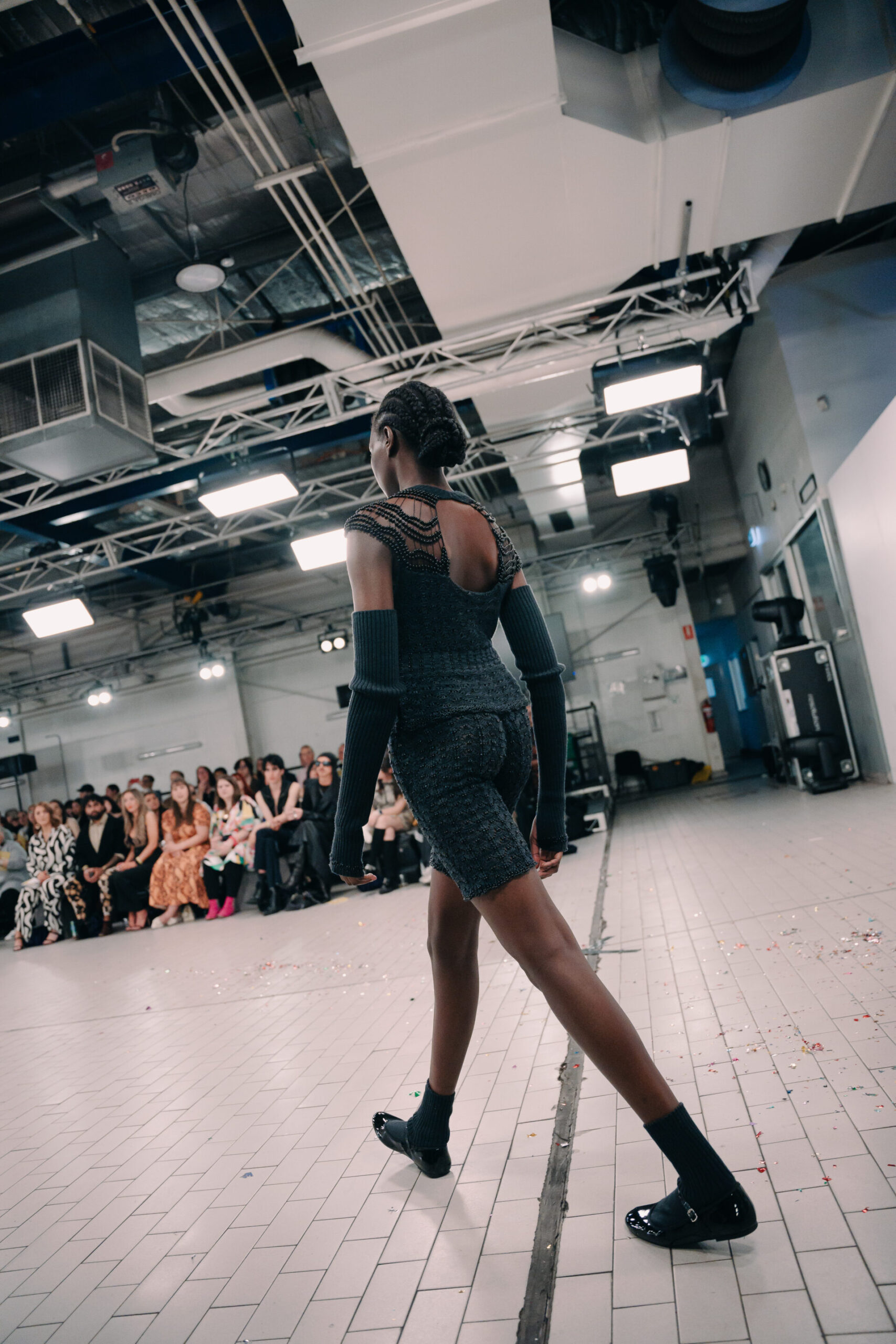Highlights from Melbourne Fashion Week's Student Show

The carpark off Waterfall Lane and Southbank Boulevard provided a subterranean-style setting for fashion students from Kangan, RMIT, Whitehouse Institute of Design Australia, Holmesglen, and Box Hill Institute to showcase their work. Here we share our highlights from the evening and celebrate RMIT students Rubee Hay and Alexandra Groves, who were jointly presented with the M/FW Student Award.
Laura Heron
Wishing to reduce the division between market and creativity, Laura Heron fuses good design with ideas of desire and sustainability. Oigåll, the artist-run space on Gertrude Street, Fitzroy, provides a platform for this indivisible fusion, allowing her to collaborate and learn.
Musing on what she would want to wear in two years’ time, Heron employs aesthetics from furniture and product design—Bauhaus and de Stijl—drawing on unexpected approaches to the body and how we design for it.
Moira Rodriguez
What is apparent when viewing Rodriguez’s work is the objectivity she instills in her garments. Collaborating with stylist Stuart Walford, this objective approach affords her emotional distance. She shares, "[We] can get too close to the things we make.” Even at an arm’s distance, Rodriguez’s relationship to the human form is inextricable. This is shown in the form of each piece, with the backs of skirts falling away and exposing the lining; ties and vertically bound strips tracing the wearer’s figure; and truncated dresses baring models’ midriffs, nodding to the trend of lingerie as outerwear.
This sense of the ‘underneath’ is consistently revealed: bodies are renegotiated with the exposure of skin. between subject and object. Redefining and showcasing the body in this new way, Rodriguez seeks to achieve greater diversity—including how we produce and realise garments—not limited to casting for publicity tricks or PR.
Matthew Buxton Lewis
In a novel way, Buxton Lewis negotiates our needs, constructing garments that are transformative and adaptive. His trench coat, which is initially held together by snap domes, morphs into a pair of trousers with interventions made by the wearer. While Lewis cites Hussein Chalayan as a foregrounding influence (Chalayan’s ‘Geotrophics’ collection explored an “involuntary and dramatic forced mobility”—something that is pressing in current global border politics), he adds levity by engaging in pop culture, musings on taste, and leaping off topics from camp to cringe. In all his work, Lewis injects a sense of play into concepts of sustainability and modular dressing. His use of colour and fabric is confident, allowing for infinite re-imagining and interpretation.

Rubee Hay
Visceral and textual would be the best adjectives to describe Rubee Hay’s designs. Preferring to delve into the symbolic reasons for dress, she questions why we choose to wear clothing. With a preference for developing an artistic practise (Hay is also accomplished in other mediums, including drawing), she wishes to create in a manner that is removed from market forces and detached from the focus of selling. As she reflects, “[While] we produce clothing in an ethical way, it can still be unethical”. Female photographer Luo Yang (Hay pointed to her ‘Girls’ series), and authors Clarice Lispector and Annie Ernaux informed her literary education and aesthetic, which in turn helped her construct her own narrative.
Hay’s garments either hug the wearer (as seen in her wool outerwear) or cut away and drape from the body. Hay’s investment in construction and process, which is also a deeply personal one, makes for garments that have longevity and care as their focus.
Models are accessorised with a small stuffed felted wool Greyhound called Bevan; he serves little function other than as an aesthetic and comfort device.
Alexandra Groves
In a time where production, expectation, and the rapid rotation of designers can take the reins at fashion houses, Alexandra Groves suggests we slow down and appreciate the craft of fashion. Her knits are fully fashioned, which minimises any off-cuts (and subsequent waste), which, as Groves adds, makes them circular too. Details such as cut-outs, trompe l’oeil necklaces, and techniques that almost resemble laddering with bead embellishment all add interest to the usual knit and purl fare.
Groves hopes that her pieces will endure. This wish is part of the sentimentality she applies to all her garments, preferring to repair and mend in a rejection of disposing. Her knit pieces in shades of Spanish grey are inspired by her backwards glance at 1960s couture fashion, namely the work of Cristobel Balenciaga. Balenciaga was known for his use of fabric, once stating “The fabric decides”. There are also touches of Yves Saint Laurent’s tenure at Dior and his successor, Marc Bohan. You can see this couture sensibility not only in her shaping but also in the intelligent sense of restraint she executes.
Some of the looks appear modest; socks with flats and longer lengths in the jersey skirts give the appearance of uniform dressing, perhaps alluding to those worn by staff at an atelier or in the service industry from that same period. This is best exemplified by Catherine Deneuve’s portrayal of a beautician in Repulsion or by Jeanne Moreau's Diary of a Chambermaid.
The Valet is Holding a Secret Party and You’re Invited
By To Be Team
Local Decadence: the Many Lives of Posture Studio
By Mia Lewin
How Melbourne’s favourite upcoming designers are redefining the codes of making and showing fashion in a post-pandemic industry
By Briony Wright
“EVERY DESIGNER HAS A STORY”
By Hugh Barton








